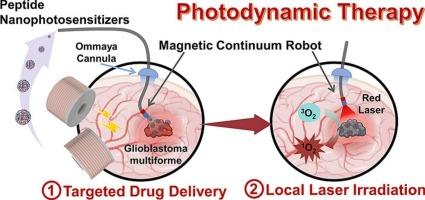Magnetic continuum robot-mediated intracranial delivery of peptide nanophotosensitizers for glioblastoma photodynamic therapy
IF 6
2区 医学
Q2 MATERIALS SCIENCE, BIOMATERIALS
Materials Science & Engineering C-Materials for Biological Applications
Pub Date : 2025-08-11
DOI:10.1016/j.bioadv.2025.214458
引用次数: 0
Abstract
Effective treatment of glioblastoma (GBM) remains a significant clinical challenge. Although photodynamic therapy (PDT) is a promising anticancer treatment method, its clinical application in GBM is limited by poor light penetration through the skull and insufficient drug delivery across the blood–brain barrier (BBB). Here, an innovative magnetic continuum robot (MCR)-mediated intracranial PDT strategy is proposed. The MCR enters the cranial cavity via an Ommaya device, enabling direct delivery of photodynamic nanoparticles (PNPs) to the tumor region and localized laser irradiation through an integrated optical fibre. PNPs, self-assembled from an aromatic short peptide and a porphyrin derivative, were employed owing to their favorable biocompatibility and photosensitivity. To ensure precise navigation within the brain, a closed-loop control system was developed, leveraging the MCR's active deflection capabilities under an electromagnetic driving system. In vitro studies confirmed that this PDT approach effectively induced GBM cell apoptosis, while in vivo experiments demonstrated efficient intratumoral accumulation of PNPs and significant tumor suppression. This strategy bypasses the BBB and enables site-specific light activation, thereby enhancing PDT efficacy. Overall, this robot-guided therapeutic platform represents a promising advance for precision PDT in GBM treatment.

磁连续体机器人介导的肽纳米光敏剂颅内递送用于胶质母细胞瘤光动力治疗
胶质母细胞瘤(GBM)的有效治疗仍然是一个重大的临床挑战。虽然光动力疗法(PDT)是一种很有前景的抗癌治疗方法,但其在GBM中的临床应用受到颅骨光线穿透性差和血脑屏障(BBB)药物递送不足的限制。本文提出了一种创新的磁连续体机器人(MCR)介导的颅内PDT策略。MCR通过Ommaya装置进入颅腔,可以将光动力纳米颗粒(PNPs)直接输送到肿瘤区域,并通过集成光纤进行局部激光照射。PNPs由芳香短肽和卟啉衍生物自组装而成,具有良好的生物相容性和光敏性。为了确保大脑内的精确导航,开发了一个闭环控制系统,利用电磁驱动系统下MCR的主动偏转能力。体外研究证实,PDT方法可有效诱导GBM细胞凋亡,体内实验显示PNPs在瘤内的有效积累和显著的肿瘤抑制作用。该策略绕过血脑屏障,实现特定位点的光激活,从而提高PDT的疗效。总的来说,这个机器人引导的治疗平台代表了精确PDT治疗GBM的一个有希望的进步。
本文章由计算机程序翻译,如有差异,请以英文原文为准。
求助全文
约1分钟内获得全文
求助全文
来源期刊
CiteScore
17.80
自引率
0.00%
发文量
501
审稿时长
27 days
期刊介绍:
Biomaterials Advances, previously known as Materials Science and Engineering: C-Materials for Biological Applications (P-ISSN: 0928-4931, E-ISSN: 1873-0191). Includes topics at the interface of the biomedical sciences and materials engineering. These topics include:
• Bioinspired and biomimetic materials for medical applications
• Materials of biological origin for medical applications
• Materials for "active" medical applications
• Self-assembling and self-healing materials for medical applications
• "Smart" (i.e., stimulus-response) materials for medical applications
• Ceramic, metallic, polymeric, and composite materials for medical applications
• Materials for in vivo sensing
• Materials for in vivo imaging
• Materials for delivery of pharmacologic agents and vaccines
• Novel approaches for characterizing and modeling materials for medical applications
Manuscripts on biological topics without a materials science component, or manuscripts on materials science without biological applications, will not be considered for publication in Materials Science and Engineering C. New submissions are first assessed for language, scope and originality (plagiarism check) and can be desk rejected before review if they need English language improvements, are out of scope or present excessive duplication with published sources.
Biomaterials Advances sits within Elsevier''s biomaterials science portfolio alongside Biomaterials, Materials Today Bio and Biomaterials and Biosystems. As part of the broader Materials Today family, Biomaterials Advances offers authors rigorous peer review, rapid decisions, and high visibility. We look forward to receiving your submissions!

 求助内容:
求助内容: 应助结果提醒方式:
应助结果提醒方式:


